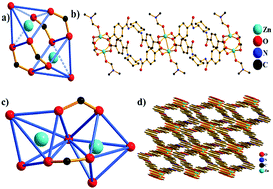Temperature-induced self-assembly of two kinds Zn(ii)-based coordination polymers with luminescence properties for application in sensing and adsorption†
Abstract
Temperature-induced self-assembly of coordination polymers (CPs) is of great importance for structural tunability and is quite necessary for further research on structure–property relationships. Two types of CPs {[Zn(L)(DMF)]·3DMF}n (1) (H2L = 4,4′-(trans-cyclohexane-1,2 diyl)bis(azanediyl)bis(carbonyl)dibenzoic acid, DMF = N,N-dimethylformamide) and {ZnL}n (2) are synthesised by the reaction of Zn(NO3)2·6H2O with H2L at different reaction temperatures. CP 1 with a one-dimensional structure is obtained at room temperature, 35 °C and 45 °C. CP 2 with a two-dimensional structure is prepared by heating at 75 °C. When the temperature is further increased to 85 °C, 95 °C, 105 °C and 120 °C, CP 2 could still be obtained. Considering the decomposition of ligands and carbonization of solvents at high temperature, 120 °C is chosen as the temperature endpoint in the experiment. Single crystal X-ray diffraction analysis indicates that 1 has a chain structure formed by binuclear metal clusters and a bridged carboxylate group. It also indicates that 2 shows a layered structure formed through intermolecular interactions between two adjacent chain motifs. The luminescence properties of 1 and 2 are explored at room temperature in the solid-state. The luminescence intensities of 1 and 2 are weak due to the N–H vibration of the ligand. In order to improve their luminescence properties, we attempt to introduce lanthanide(III) ions into their channels. Only 2 can accept lanthanide ions Eu3+ and Tb3+ and still maintain its framework, as confirmed by PXRD. Besides, 2 can also sensitize them well. Therefore, the luminescence properties of 2 are improved vastly. The doped material can emit bright red and green light of Eu3+ and Tb3+. A series of EuxTb(1−x)@ZnL coordination polymers are prepared using a post-synthesis method to realize white light emission. The luminescent material Tb3+@ZnL shows a highly sensitive quenching effect to acetone among common solvents. The characteristic emission of Tb3+ could be quenched in the presence of 8 vol% acetone. In addition, 2 could selectively adsorb methylene blue (MB) due to its porosity and can act as a green adsorbent. Compared to 1, 2 is a promising multifunctional material for applications in photoluminescence, luminescent detection and dye adsorption.



 Please wait while we load your content...
Please wait while we load your content...